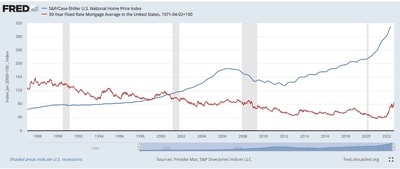Memories of 2007/2008 still linger in our minds. It was the beginning of what turned out to be a deep and wide recession, emanating from excesses in the housing market and loans from banks. You didn’t know where the bottom was — so working in markets, you took time minute by minute, hour by hour. You knew logically it would eventually be an opportunity, but fear was high. Because if you didn’t have a job, opportunities didn’t matter. Nationally, home prices from bottom to peak in the cycle leading up to that (1991 to 2006) increased by 6% per year. For the next six years, they fell by 4% per year. In this most recent housing cycle (2012 to 2022), the trough-to-peak increase in home values was 8% per year. I think because of this, many people might see housing as binary: Values are either rallying or collapsing. However, the reality is much more nuanced. Real estate, after all, is still local, properties differ as much as people, and people make all sorts of decisions.
For some context first, here’s a chart of national home prices in blue and 30-year mortgage rates in red, going back to 1987.
One main driver of property values is mortgage interest rates. Generally, the lower the rate, the less expensive it is to purchase the home — often leading to greater demand and higher values — and vice versa. Thirty-year mortgage rates fell by 65% from 2000 to 2020, while home values rose. However, since the start of this year, they are up about 100%... to levels not seen since 2008 (or 2001 depending on the specific metric). This has quickly made it much less affordable for the average family to buy a home. According to the National Association of Realtors, their Housing Affordability Index has dropped by 30% from December 2021 to July 2022. What that translates to in actual dollars — the monthly payment (P&I*) on a median-priced single-family home jumped from $1,256 to $1,861 over this period. That’s meaningful. While underlying consumer fundamentals like employment and income remain relatively healthy, the median income increases have not offset the rising costs of borrowing to buy a house.
The other side of property values is supply — aka are more or fewer houses for sale now, and have the offer prices stayed the same?
Well, the National Association of Realtors data on the supply of existing homes has increased from 2.6 months worth to 3.2 months worth year-over-year. With rising mortgage rates, falling affordability, and resulting higher supply, home prices have just started to fall. The S&P CoreLogic Case-Shiller 20-City Home Price Index was negative in the most recently reported month for the first time since 2012. Homebuilders have been reacting to lower prices as well. Residential construction and housing starts have both begun to roll over. There are fewer buyers out there, due to affordability, or maybe also that many people made their purchases while rates were lower. In fact, underlying the latter point, the San Francisco Fed recently published an Economic Letter stating, “The shift to remote work may account for more than half of overall house price increases and similar increases in rents.” With this work-from-home transition fully established and more going back to the office now, this support should cool, if not go away.
Overall, it feels like the rise in rates, the fall in affordability, and the depletion of personal savings have to make a dent in home values, right?
